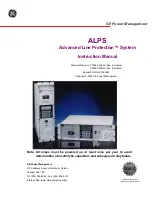
18
O
PER
AT
O
R
IN
TER
FA
CE
TEMP ICON
The TEMP indicator icon displays two possible fault
conditions in relation to the operating temperature of the
SPCi, details as follows:
1. Pre-emptive alarm condition.
The TEMP icon is illuminated intermittently (pulsing
red) and the alarm output is activated (to external
warning device if connected). In this condition the SPCi
internal temperature is rising and exceeding factory
preset level. The unit will continue to operate in this
condition providing the temperature does not escalate
to shutdown mode. The alarm condition is self-resetting
should the fault condition revert to normal.
2. Shutdown alarm condition.
The TEMP icon is illuminated continuously (steady red)
and the alarm output is activated (to external warning
device if connected).
In this condition the SPCi internal temperature has risen
above the safe operating level. The unit will shut down
and no output is available until such time as the problem
is rectifi ed. The alarm condition is self-resetting should
the fault condition revert to normal.
20
O
PER
AT
O
R
IN
TER
FA
CE
OUTPUT ICON
The OUTPUT indicator icon displays fi ve possible fault
conditions in relation to the OUTPUT (24V) voltage supply
to the SPCi, details as follows:
1. Pre-emptive alarm condition.
The OUTPUT icon is illuminated intermittently (pulsing
red) and the alarm output is activated (to external
warning device if connected). In this condition the SPCi
output (24V) is either:
– Over loaded intermittently (>100% but <125% of
continuous rating of SPCi). The unit will continue to
operate in this condition providing the overload does
not escalate to shutdown mode. The alarm condition
is self-resetting should the fault condition revert
to normal. The load bar indicator will also indicate
amber (125%) in this condition.
– Low voltage (charge mode only). In this condition
the SPCi output voltage is falling below factory
preset level. The unit will continue to operate in
this condition providing the voltage does not fall
to shutdown mode. The alarm condition is self-
resetting should the fault condition revert to normal.
19
O
PER
AT
O
R
IN
TER
FA
CE
INPUT ICON
The INPUT indicator icon displays two possible fault
conditions in relation to the input (24V) voltage supply to the
SPCi, details as follows:
1. Pre-emptive alarm condition.
The INPUT icon is illuminated intermittently (pulsing red)
and the alarm output is activated (to external warning
device if connected). In this condition the SPCi input
voltage is falling below factory preset level. The unit will
continue to operate in this condition providing the voltage
does not fall to shutdown mode. The alarm condition is
self-resetting should the fault condition revert to normal.
2. Shutdown alarm condition.
The INPUT icon is illuminated continuously (steady red)
and the alarm output is activated (to external warning
device if connected). In this condition the SPCi input
voltage has fallen below the permissible minimum
operating level. The unit will shut down and no output
is available until such time as the problem is rectifi ed.
The alarm condition is self-resetting should the fault
condition revert to normal.
21
O
PER
AT
O
R
IN
TER
FA
CE
2. Shutdown alarm condition.
The OUTPUT icon is illuminated continuously
(steady red) and the alarm output is activated.
In this condition the SPCi output is either:
– Over loaded continuously (>125% of continuous
rating of SPCi). The unit will shut down and
no output is available until such time as the
problem is rectifi ed. The alarm condition is
self-resetting should the fault condition revert to
normal.
– Short circuited. The unit will shut down and
no output is available until such time as the
problem is rectifi ed. The alarm condition is
self-resetting should the fault condition revert to
normal.
– Low voltage (charge mode only). In this
condition the SPCi output voltage has fallen
below the permissible minimum operating level.
The unit will shut down and no output is available
until such time as the problem is rectifi ed. The
alarm condition is self-resetting should the fault
condition revert to normal.
























